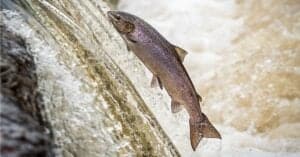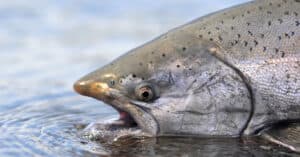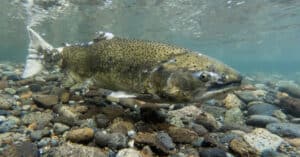Steelhead vs Salmon: What’s the Difference?
@media (min-width: 481px) {
.mobile-top-content {
display: none;
}
}
#mobileTopContentCTACarouselControls { overflow: hidden; text-overflow: ellipsis; white-space: nowrap; }
.mobile-top-content .more { color: #fff; }
.mobile-top-content a { color: #fff; text-decoration: underline; }
.mobile-top-content a:hover { color: #fff; text-decoration: underline; }
@media (max-width: 480px) {
.mobile-top-content {
background-color: #06a10b;
color: #fff;
text-align: center;
/*height: 60px;
padding-top:5px;*/
font-size:80%;
/* display: block; */
margin: 0px -30px;
}
}
When it comes to comparing steelhead vs salmon, you may be asking yourself: what’s the difference? There are many more than you have likely considered, including the main difference in their genuses. For example, the steelhead scientific name is Oncorhynchus mykiss while salmons have many differing scientific names, depending on their breed. However, it is important to note that the primary difference between steelhead and salmon is the fact that steelheads are trout!
In this article, we will compare and contrast these two fish so that you can fully understand the ways in which they are different. You will also learn how to tell these two fish apart, though they do look strikingly similar. Let’s get started and learn more now.
Comparing Steelhead vs Salmon
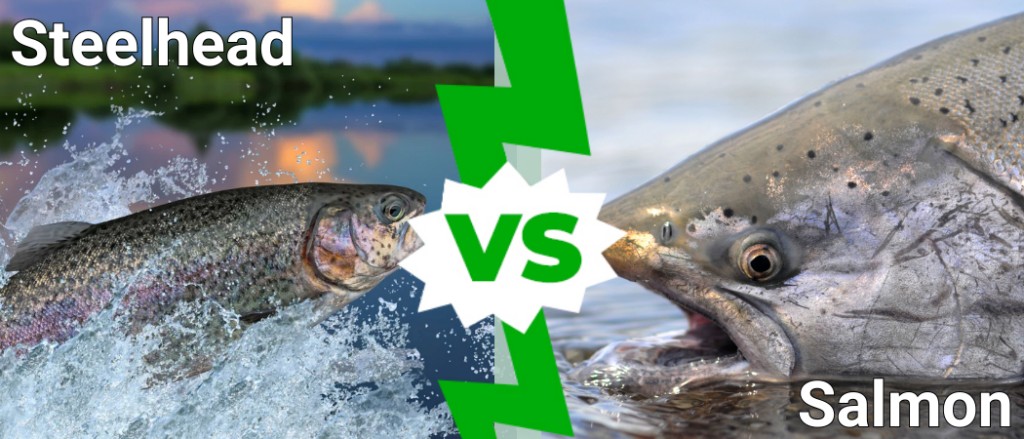
A-Z-Animals.com
| Steelhead | Salmon | |
|---|---|---|
| Size | 25 inches maximum | 40 inches maximum |
| Species | Trout | Salmon |
| Appearance | Pink stripe visible among speckled scales; white mouth | No pink stripe; gray and speckled body, dark mouth |
| Weight | 20 pounds, on average | 30-40 pounds, on average |
| Habitat | Seas and rivers | Seas unless they need to spawn |
The Main Differences Between Steelhead vs Salmon
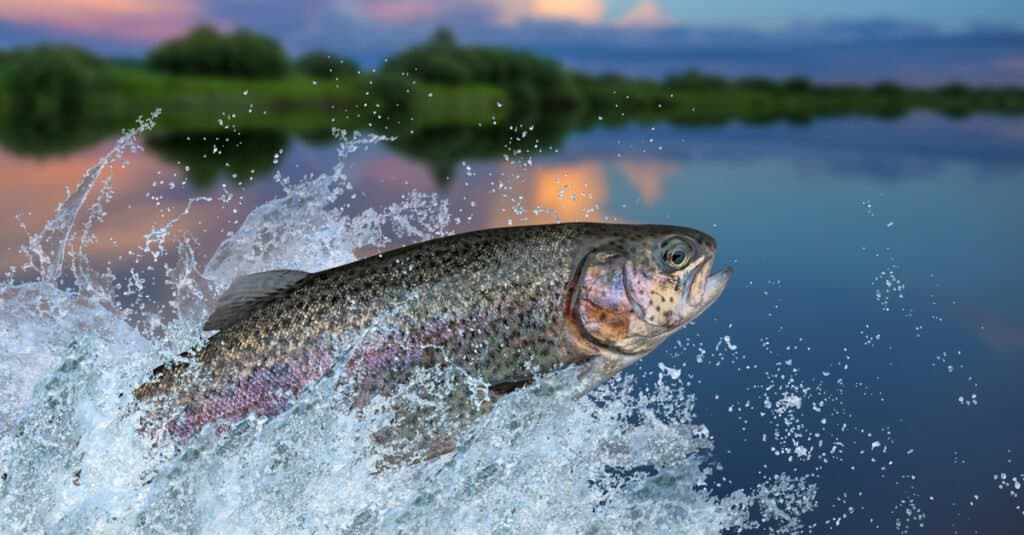
FedBul/Shutterstock.com
There are many key differences between steelhead vs salmon. Steelheads are trout, not salmon at all. Salmon also tend to get much larger than steelheads, depending on their specific breed of salmon. Steelheads can also only be found in the sea while salmon make their journey from the sea and upriver so that they can spawn.
Let’s discuss these differences in more detail now.
Steelhead vs Salmon: Size
One of the key differences between steelhead trout and salmon can be found in their overall size. For example, steelheads remain much smaller than salmon on average, measuring no more than 25 inches on average; salmon can grow up to 40 inches on average, depending on the type of salmon that they are.
However, given that both of these measurements are just averages, they may not help you when it comes time to identify whether or not you have caught a steelhead trout or a salmon. Both fish have the tendency to grow far beyond these measurements, as some steelheads reach over 45 inches in length, depending on their environment. This would easily confuse the average fisherman, given that salmon also grow to this length.
While steelhead trout can be found in both seas and rivers, the trout that choose to migrate to the sea always grow larger than their river bound counterparts. However, steelheads never grow quite as large as salmon do on average, whether or not they migrate to the ocean.
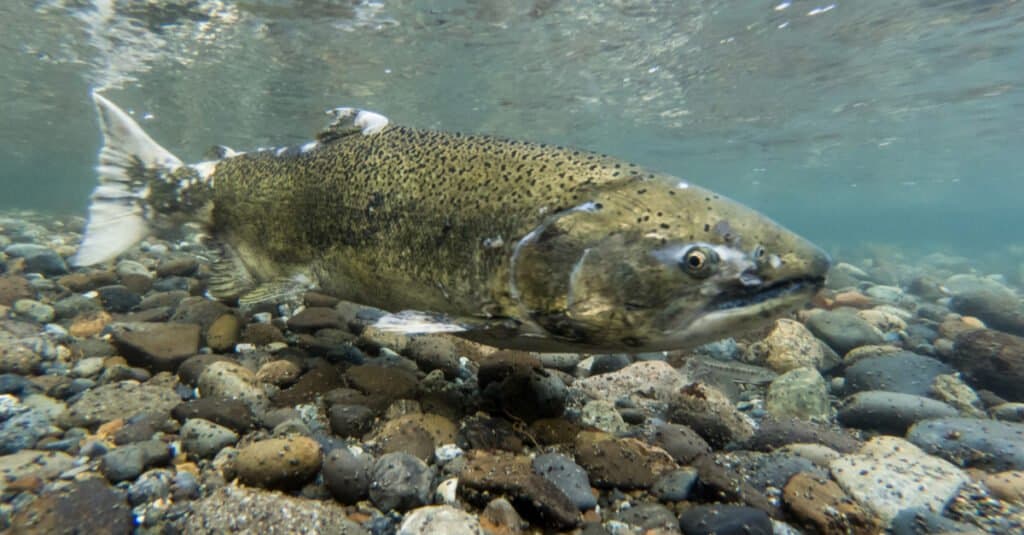
Kevin Cass/Shutterstock.com
Steelhead vs Salmon: Species
Another key difference between steelhead and salmon can be found in their basic species classification. While both fish are from the salmon family, steelhead trout are also known as rainbow trout or Oncorhynchus mykiss. Salmon are known by a wide variety of names, depending on their specific breed, but no salmon varieties are called trout.
Steelhead vs Salmon: Appearance
Steelhead and salmon continue to differ in their overall appearance. While you may not be able to tell unless you have both fish side-by-side, steelhead usually have a skinnier body than a salmon. Many salmon species also have hooked noses, while steelhead trout will not.
Both fish varieties have speckles as well as many different colored markings, such as pink bellies and green tails. However, there is one telltale sign that you can look for in order to tell steelhead vs. salmon apart. Steelhead trout have white mouths and gums, while just about every variety of salmon will have a dark or black mouth and gum line.
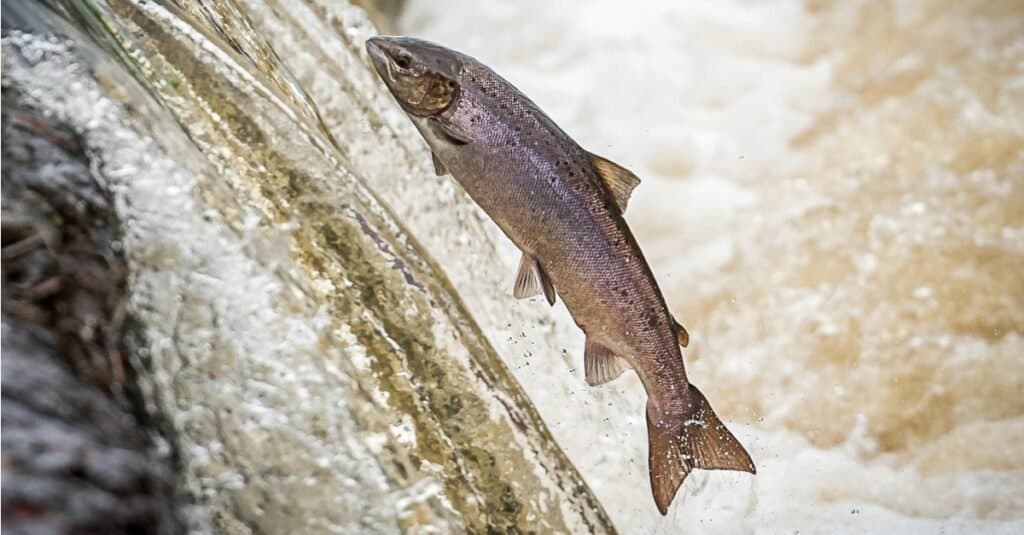
iStock.com/PerfectStills
Steelhead vs Salmon: Weight
Another key difference between steelhead vs salmon lies in their overall weight. While both of these fish can grow to be roughly the same size and can look strikingly similar, many different varieties of salmon often outweigh the average steelhead.
For example, the average steelhead trout weighs roughly 25 pounds, though it can reach up to 50 pounds, especially if it has migrated to live in the ocean. Salmon, in contrast, weigh an average of 40 pounds, depending on the specific breed. There have even been reports of some salmon weighing as much as 80 pounds!

The Old Major/Shutterstock.com
Steelhead vs Salmon: Habitat and Migration Habits
The final key difference between steelhead vs salmon lies in their habitats and migration habits. We all know that salmon swim upstream in order to spawn their young before dying, and steelhead performs in much the same way. However, there’s one key difference in this process.
Both of these fish are considered anadromous, though steelhead often choose whether they want to live in the sea or river. Salmon do not share the same luxury, living most of their life in the sea until it is time to swim upriver and spawn.
Benefits that steelhead have over salmon lie in their ability to breed more than once. Salmon species are capable of spawning upstream once before passing on, while steelhead trout are capable of spawning multiple times in a lifetime. This means that they make their treacherous journey upstream more than once, but it also means that they breed more young than the average salmon does.
More from A-Z Animals
.more-snake-card-image { max-height:140px !important; }
@media (min-width: 481px) {
.mobile-top-content {
display: none;
}
}
#mobileTopContentCTACarouselControls { overflow: hidden; text-overflow: ellipsis; white-space: nowrap; }
.mobile-top-content .more { color: #fff; }
.mobile-top-content a { color: #fff; text-decoration: underline; }
.mobile-top-content a:hover { color: #fff; text-decoration: underline; }
@media (max-width: 480px) {
.mobile-top-content {
background-color: #06a10b;
color: #fff;
text-align: center;
/*height: 60px;
padding-top:5px;*/
font-size:80%;
/* display: block; */
margin: 0px -30px;
}
}
When it comes to comparing steelhead vs salmon, you may be asking yourself: what’s the difference? There are many more than you have likely considered, including the main difference in their genuses. For example, the steelhead scientific name is Oncorhynchus mykiss while salmons have many differing scientific names, depending on their breed. However, it is important to note that the primary difference between steelhead and salmon is the fact that steelheads are trout!
In this article, we will compare and contrast these two fish so that you can fully understand the ways in which they are different. You will also learn how to tell these two fish apart, though they do look strikingly similar. Let’s get started and learn more now.
Comparing Steelhead vs Salmon

A-Z-Animals.com
| Steelhead | Salmon | |
|---|---|---|
| Size | 25 inches maximum | 40 inches maximum |
| Species | Trout | Salmon |
| Appearance | Pink stripe visible among speckled scales; white mouth | No pink stripe; gray and speckled body, dark mouth |
| Weight | 20 pounds, on average | 30-40 pounds, on average |
| Habitat | Seas and rivers | Seas unless they need to spawn |
The Main Differences Between Steelhead vs Salmon

FedBul/Shutterstock.com
There are many key differences between steelhead vs salmon. Steelheads are trout, not salmon at all. Salmon also tend to get much larger than steelheads, depending on their specific breed of salmon. Steelheads can also only be found in the sea while salmon make their journey from the sea and upriver so that they can spawn.
Let’s discuss these differences in more detail now.
Steelhead vs Salmon: Size
One of the key differences between steelhead trout and salmon can be found in their overall size. For example, steelheads remain much smaller than salmon on average, measuring no more than 25 inches on average; salmon can grow up to 40 inches on average, depending on the type of salmon that they are.
However, given that both of these measurements are just averages, they may not help you when it comes time to identify whether or not you have caught a steelhead trout or a salmon. Both fish have the tendency to grow far beyond these measurements, as some steelheads reach over 45 inches in length, depending on their environment. This would easily confuse the average fisherman, given that salmon also grow to this length.
While steelhead trout can be found in both seas and rivers, the trout that choose to migrate to the sea always grow larger than their river bound counterparts. However, steelheads never grow quite as large as salmon do on average, whether or not they migrate to the ocean.

Kevin Cass/Shutterstock.com
Steelhead vs Salmon: Species
Another key difference between steelhead and salmon can be found in their basic species classification. While both fish are from the salmon family, steelhead trout are also known as rainbow trout or Oncorhynchus mykiss. Salmon are known by a wide variety of names, depending on their specific breed, but no salmon varieties are called trout.
Steelhead vs Salmon: Appearance
Steelhead and salmon continue to differ in their overall appearance. While you may not be able to tell unless you have both fish side-by-side, steelhead usually have a skinnier body than a salmon. Many salmon species also have hooked noses, while steelhead trout will not.
Both fish varieties have speckles as well as many different colored markings, such as pink bellies and green tails. However, there is one telltale sign that you can look for in order to tell steelhead vs. salmon apart. Steelhead trout have white mouths and gums, while just about every variety of salmon will have a dark or black mouth and gum line.

iStock.com/PerfectStills
Steelhead vs Salmon: Weight
Another key difference between steelhead vs salmon lies in their overall weight. While both of these fish can grow to be roughly the same size and can look strikingly similar, many different varieties of salmon often outweigh the average steelhead.
For example, the average steelhead trout weighs roughly 25 pounds, though it can reach up to 50 pounds, especially if it has migrated to live in the ocean. Salmon, in contrast, weigh an average of 40 pounds, depending on the specific breed. There have even been reports of some salmon weighing as much as 80 pounds!

The Old Major/Shutterstock.com
Steelhead vs Salmon: Habitat and Migration Habits
The final key difference between steelhead vs salmon lies in their habitats and migration habits. We all know that salmon swim upstream in order to spawn their young before dying, and steelhead performs in much the same way. However, there’s one key difference in this process.
Both of these fish are considered anadromous, though steelhead often choose whether they want to live in the sea or river. Salmon do not share the same luxury, living most of their life in the sea until it is time to swim upriver and spawn.
Benefits that steelhead have over salmon lie in their ability to breed more than once. Salmon species are capable of spawning upstream once before passing on, while steelhead trout are capable of spawning multiple times in a lifetime. This means that they make their treacherous journey upstream more than once, but it also means that they breed more young than the average salmon does.



